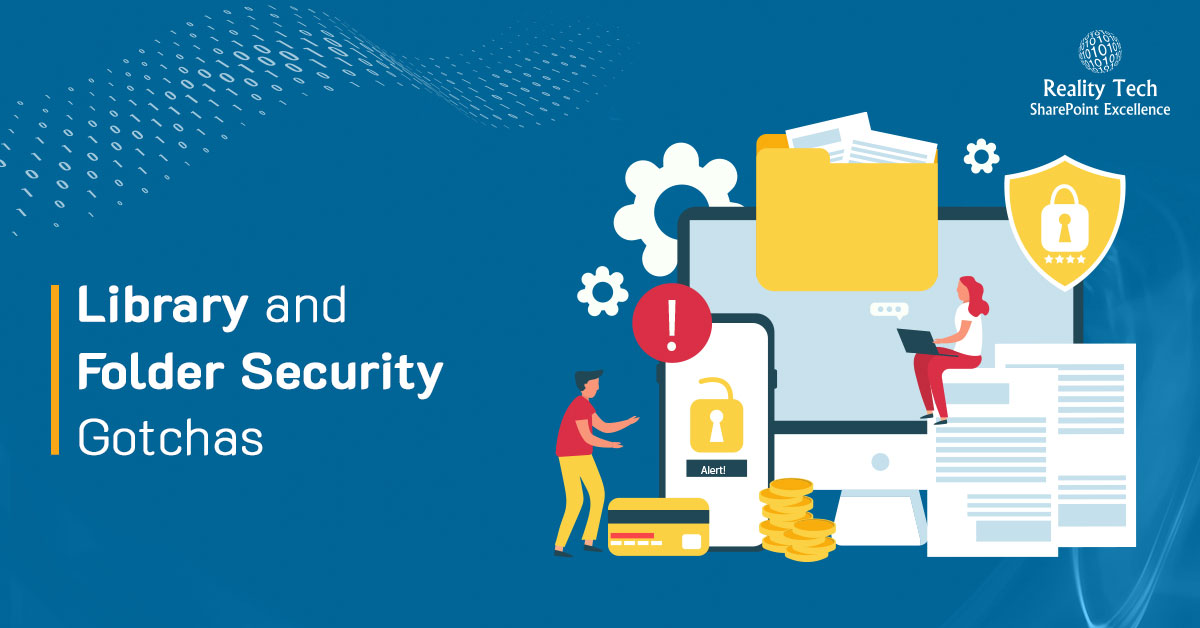
Document libraries and folders are the backbone of SharePoint. They hold your critical business files, organize collaboration, and control who sees what. But here’s the catch if you don’t plan your library and folder security correctly, your SharePoint environment can quickly spiral into confusion, performance bottlenecks, and compliance risks.
When Reality Tech first wrote about library security issues more than a decade ago, SharePoint looked very different. Today, with Microsoft 365, SharePoint Online, and Teams integration, the rules have changed but the risks are still very real.
In this updated guide, we’ll explore the modern folder security issues you need to avoid and how Reality Tech’s Expert SharePoint Services help you stay secure, compliant, and efficient.
Hitting SharePoint Limits the Hard Way
Every SharePoint environment has limits, and ignoring them is one of the biggest mistakes organizations make.
- Security scope limit: SharePoint Online allows up to 50,000 unique permission scopes per library. Break inheritance too many times (e.g., folder-by-folder permissions) and you’ll run into errors, performance issues, or even access problems.
- URL and path length: Long folder nesting creates broken links or sync failures, especially since the maximum URL length is still limited (~400 characters).
- List/library thresholds: If you dump too many items without metadata or indexing, queries and performance take a nosedive.
Overusing Folders Instead of Metadata
Folders feel natural, but in modern SharePoint, they can be more of a curse than a blessing:
- They create rigid structures that are hard to change.
- Deep nesting breaks usability and causes long paths.
- Searching becomes painful if metadata isn’t in place.
Instead, Microsoft recommends metadata-driven libraries. With metadata, you can filter, sort, and group files dynamically without locking them into rigid folder paths.
Example: Instead of HR > 2025 > Contracts > Region > Employee Name, use metadata tags for year, document type, region, and employee. The same file can then appear in multiple useful “views.”
Breaking Permission Inheritance Too Often
One of the most common security gotchas in SharePoint is overusing unique permissions.
Sure, giving a single user access to one folder may feel convenient, but multiply that by hundreds of requests, and soon your folder security issues explode. This leads to:
- Confusing access structures
- Admin headaches (“Who has access to what?”)
- Risk of unintentional exposure
Instead of folder-level permissions, Microsoft recommends:
- Group-based permissions (via Microsoft 365 Groups or AD security groups)
- Document library or site-level security
- Sensitivity labels and DLP policies for granular control
Ignoring Governance and Compliance
SharePoint document library security isn’t just about permissions; it’s also about governance. You must ensure your structure stays clean, consistent, and compliant.
Common governance library security issues include:
- Inconsistent naming conventions (typos, duplicates, “final_final_v2.docx”)
- No retention or deletion policies
- Missing version control or audit logging
- No standardized metadata
These mistakes don’t just frustrate users, they create compliance risks.
At Reality Tech, our Security and Compliance Services help organizations implement governance frameworks:
- Naming conventions and content type policies
- Retention labels and records management
- Version history and audit logging
- Automated policies for tagging and classification
Forgetting Automation Opportunities
A decade ago, managing folder permissions was tedious and manual. Today, with Power Automate, you can enforce SharePoint security best practices automatically:
- Break permission inheritance only when specific conditions are met
- Send alerts when users request access
- Automatically apply retention labels to certain file types
- Move files to secure libraries when they contain sensitive data
Yet most organizations don’t leverage automation for SharePoint Services.
Not Leveraging Modern Features
The SharePoint of 2025 is not the SharePoint of 2012. Many teams are still stuck using it like a file share, missing out on modern features:
- Teams & OneDrive Integration – Libraries sync seamlessly across devices and chat channels.
- Improved Document Sets – Group related files with shared metadata and workflows.
- Bulk Operations – Modern libraries allow bulk tagging, editing, and sharing.
- IRM & Sensitivity Labels – Prevent printing, copying, or unauthorized sharing.
- Copilot AI Assistance – Search, summarize, and retrieve content quickly.
Treating SharePoint Like Just Another File Server
Perhaps the biggest mistake of all: using SharePoint like a traditional file share.
When you treat SharePoint as “just storage,” you lose its real power:
- Dynamic metadata and views
- Integrated workflows
- Compliance features
- Advanced search
- Audit and analytics
SharePoint is a platform for secure, governed collaboration not a shared drive with a new name.
Conclusion
Library and folder security in SharePoint can be a minefield. From hidden limits to broken inheritance, from compliance oversights to underused modern features the risks are real.
But the good news is, you don’t have to navigate them alone.
At Reality Tech, we’ve spent years helping organizations:
- Design scalable, metadata-driven libraries
- Fix broken permission models
- Automate compliance with Power Automate
- Govern content with retention, auditing, and labels
- Unlock modern SharePoint capabilities
Whether you’re struggling with library security issues, battling folder security issues, worried about compliance, or planning a migration to SharePoint Online, Reality Tech has the expertise to guide you.
Ready to secure and optimize your SharePoint environment?
Talk to Reality Tech Expert today about our SharePoint Services and ensure your libraries are built for security, scalability, and success.
Want to talk?
Drop us a line. We are here to answer your questions 24*7.



